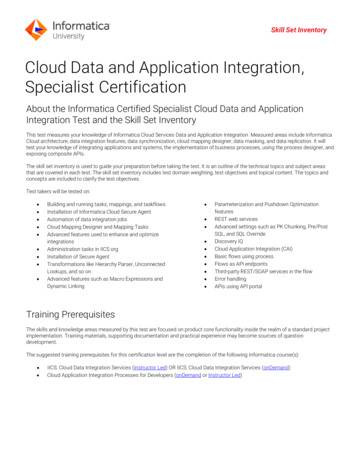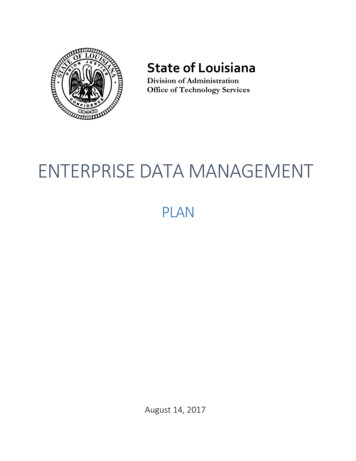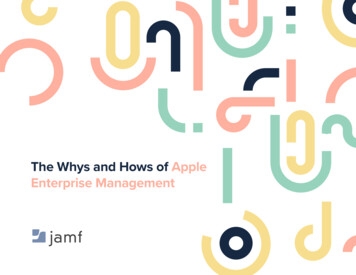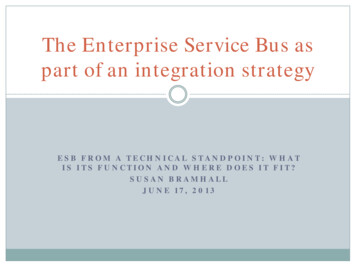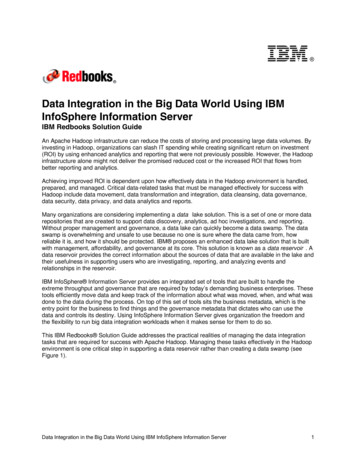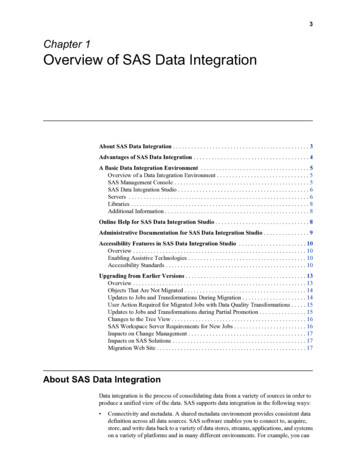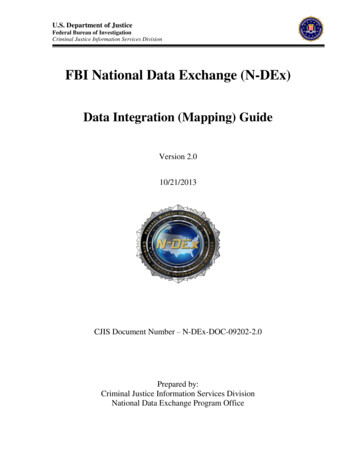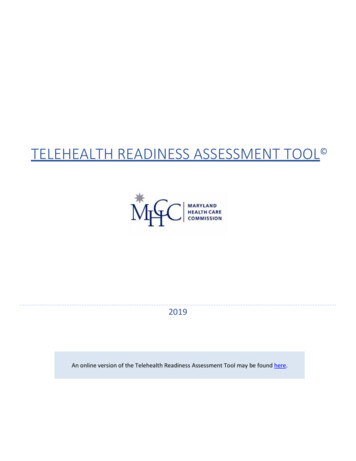
Transcription
ENTERPRISE DATA MANAGEMENT INTEGRATION READINESS PLAN FOR PHASE 0Enterprise DataManagementIntegration ReadinessPlan for Phase 0FINAL6/18/2020FINAL6/18/20200
ENTERPRISE DATA MANAGEMENT INTEGRATION READINESS PLAN FOR PHASE 0Table of ContentsOverview . 2Purpose and audience . 2Guiding principles . 3Scope . 4Assumptions. 4Background to the Integration Strategy . 4Interface patterns, types, and usage . 5One Washington Integration Strategy . 5Pre-implementation analysis . 6Impact assessment. 7Detailed Interface Plan . 10High-level timeline . 14Resource requirements. 15Dependencies. 15References . 16Interface plan definitions . 16Roles and Responsibilities . 17Additional Application Information . 19Potential technical issues . 20Best practices & lessons learned . 22FINAL6/18/20201
ENTERPRISE DATA MANAGEMENT INTEGRATION READINESS PLAN FOR PHASE 0OverviewThe Enterprise Data Management Integration Readiness Plan (EDMIRP) for Phase 0 is specifically gearedtoward increasing the technical readiness of the Office of Financial Management (OFM) Enterprise DataManagement Team, and inform agencies impacted by the build out of the OFM IT integration platformthat supports the One Washington (OneWa) program’s integration strategy.The EDMIRP is intended to address integration work in order to support OneWa Phase 0: SystemReadiness, with a focus on preparing for Phase 1A: Core Financials. It includes risks identified that mayimpact the transition to the new ERP solution as well as lessons learned from other ERPimplementations. This plan includes all the work needed to be completed by the OFM integrations teamby January 1, 2021. Future phases of work will be addressed in a separate plan. For more informationabout the scope and timeline for OneWa, please refer to the diagram below:Purpose and audienceThe purpose of the EDMIRP is to: Define the goals, objectives, guiding principles, scope, assumptions, timeline, resources, androles and responsibilities for the Integration Readiness Project.Provide a summary of the research and analysis gathered by the project team and OneWaProgram in the pre-implementation analysis.The EDMIRP is intended for use as an internal guiding document for OFM and OneWa. This documentwill also be shared with partnering agencies to provide a high-level understanding of OFM’s plannedapproach in its support of the OneWa Program. This is not meant to be an action plan for guiding thework that will need to be completed by agencies.FINAL6/18/20202
ENTERPRISE DATA MANAGEMENT INTEGRATION READINESS PLAN FOR PHASE 0Familiarization with the OneWa program and its integration strategy is crucial for understanding thisplan. It is recommended that readers have read and understood this background information.Goals and objectivesThe goals and objectives of the Integration Readiness Project are as follows: Establish the OFM team and their related skill sets to use the OFM Informatica platform insupport of the OneWa Program.Deploy the required modules and capabilities of the OFM Informatica platform to support theobjectives as defined in the OneWa Integration Strategy.Reduce the overall integration complexity, from both data and technical perspectives, anddefine standardized AFRS integration endpoints for both the ERP system integrator and OFM’sstate agency customers.o Identify all necessary agency interfaces for core financials and provide analysis on each.o Determine future interface needs and requirements.o Implement all standard interfaces needed for initial readiness by January 1, 2021 basedon analysis and recommendations (complex integrations may take longer and not becomplete by this date).o Modernize technologies necessary to support OneWa program, while supporting legacysystems so agencies can continue to send and receive data without requiring majormodifications to their line of business systems where possible.o Lay a strong, scalable foundation and minimize implementation risks.o Reduce overall footprint and associated costs related to integrations.o Reduce, and eliminate where possible, unique interfaces or exceptions for agencies.o Minimize potential impacts to other state agencies and eliminate rework by agencies.Guiding principlesThe guiding principles specific to this plan include: Use common, standard interfaces wherever possiblePromote reusabilityReduce data redundancyAlways reflect data as represented in the source systemFINAL6/18/20203
ENTERPRISE DATA MANAGEMENT INTEGRATION READINESS PLAN FOR PHASE 0ScopeIn scopeOut of scope Configuration and implementation of theInformatica platform components.Alignment with OneWa and OFM IT technicalstrategies and plans.Development of a comprehensive plan to migrateselect agency interfaces to standard integrationpoints by January 2021.Implementation of standardized interfaces tosupport core financials. Modifications to current OFM systems, such asthe TALS, TEMS, Solomon Accounts Receivable,Financial Toolbox, and HRMS GAP files* and otherbatch jobs.Other enterprise data management activities insupport of OneWa.Future nonstandard integrations, such as API andERP-specific connectors.Unique, one-off, nonstandard interfaces.*The Human Resource Management System (HRMS) is the enterprise HR and Payroll system for Washington State.HRMS captures and distributes statewide personnel, payroll, and financial data, and processes payroll. HRMS datadefinitions are on the OFM website. These definitions are focused on data integrity and consistency for reportingand analysis of workforce data. HRMS and AFRS work interdependently through integrations to process stateemployee payroll. Modifications to the existing HRMS integrations, including gap files, is out of scope for thisintegration readiness work. However, in order to successfully implement core financials, OneWA will spearhead aseparate readiness project to support the new ERP system and its data needs from HRMS. OFM State HumanResources and OFM Statewide Accounting will be consulted during this work before any changes are made.Assumptions Integration work after January 1, 2021 will be included in the OneWa system integrator workplan to ensure alignment with the ERP implementation for Phase 1a: core financials.Any other interfaces that are not related to AFRS will addressed in the corresponding phase’sintegration plan.There are no more specialized interfaces or exceptions for agencies.Leverage standard data elements to move away from the AFRS 950 transactional format.Background to the Integration StrategyCurrently, agency systems are not integrated efficiently with enterprise systems. Many agency systemsrely on point-to-point integrations or pre-built reports used to integrate with enterprise administrativesystems like AFRS. In addition, interfaces with agency systems often contain different interface layoutsand formats and require extensive effort by enterprise and agency staff to maintain. For example, thereare currently 142 unique enterprise interfaces being maintained.One of the guiding principles of the OneWa program is to provide a unified system of record (SOR) forfinance, procurement, budget, human resources, and payroll. To support this guiding principle, OneWaand OFM IT will incorporate leading ERP implementation best practices to consolidate and standardizethe interfaces to and from the ERP solution. The streamlining of integrations will ensure quality andconsistency of data integration between the ERP solution and agency systems, thereby providing aunified SOR. A unified SOR will provide the following benefits for agencies:FINAL6/18/20204
ENTERPRISE DATA MANAGEMENT INTEGRATION READINESS PLAN FOR PHASE 0 Accurate, more comprehensive, and timely data for decision makersReduced risk of major system failureMore staff time devoted to delivering the mission rather than maintaining systemsCritical business capabilities maintained without having to own all the technologyIncreased process efficiencies as many routine supporting tasks are automatedInterface patterns, types, and usageBelow are definitions of some common interface patterns, types, and usage by OFM:Publish/subscribe: Data from a source is published to a staging area. Staged data is used to createsubscriptions to customers. Subscriptions can be scheduled or triggered. This pattern ensures the samedata is extracted once and the same data from the source is distributed multiple times.Near-real-time: With respect to the frequency of an interface, can be almost instant or a schedulednear-real-time (e.g., hourly) and contains incremental or transactional changes only.Batch: With respect to the frequency of an interface, is typically for a high volume of records and isdone on a regularly cadence (e.g. once a day or once a week).Transactional: An interface containing a single record.Application Protocol Interfaces (APIs)/Services: A modern method of integration, REST or SOAP-based.APIs are consumable and have exposed addresses or endpoints. APIs can be designed to either send orretrieve data and have signatures describing what a request must look like and what the response willlook like. APIs are intended for transactional integrations, not batch-volume integrations.Secure File Transfer (SFT): OFM uses Axway, the service managed by WaTech. SFT consists of folderstructures, typically managed by an application portfolio. This mechanism allows for the movement ofsecure data via files placed and retrieved from the SFT. This method is typically used for batches.One Washington Integration StrategyThe integration strategy will ensure data quality and consistency between the ERP software solution andagency line-of-business applications, thereby providing interoperability. Consolidation andstandardization of interfaces also provides the following benefits to the state: Reduced overall integration complexityImproved transactional visibility with the system of record (SOR)Central control of interface management with the SORImproved security of data transmissionsThe integration strategy is based on the methodology of service-oriented architecture (SOA) to provideautomated real-time interfaces. SOA would allow agencies to send and receive data in a variety offormats and methods supporting standard specifications. The standard specifications for integrationswith the ERP software solution will be further defined during the implementation phases of the OneWaprogram.FINAL6/18/20205
ENTERPRISE DATA MANAGEMENT INTEGRATION READINESS PLAN FOR PHASE 0For OFM to successfully execute and implement this integration approach, it is necessary to understandthe scope of interfaces and conversion. The approach includes the following: Implementation of a middleware integration layer to maximize flexibility.Identification of all legacy applications currently interfacing with AFRS and a determinationmade to retire, replace or integrate with the ERP software solution.Determination of required interfaces and data conversions.Identification and documentation of roles and responsibilities of agencies duringimplementation.OFM has an existing integration platform currently in use and has purchased additional components forERP implementation, to include data quality management tools. The integration platform is comprisedof various components in the Informatica ecosystem. Some of these components are new and willrequire training for OFM staff members, while others are used today throughout the data managementprocess. The core platform is hosted and operated by OFM. Additionally, there are elements leveragingInformatica’s cloud-based platform, hosted by the vendor in the cloud.Component NameData Integration HubPowerCenterPowerExchange adapters:VSAM and SAPChange Data CaptureProactive MonitoringCloud Application IntegrationCloud Data IntegrationCloud API Management/PortalEnterprise Data CatalogAxonData QualityOFM Integration PlatformDescriptionPublish and subscribe service for data integrationCore ETL engineInterface modules for mainframe and SAP applications andPowerCenter for the on-premise toolsChange notification service on the mainframeSystem monitoring serviceCloud-based data aggregation and integrationCloud-based data processing at scaleCloud-based API gateway serviceData catalog and discovery serviceData governance moduleData quality and assurance modulePre-implementation analysisAs part of the initial agency readiness framework developed in early 2019 by OneWa, technologyrelated readiness activities were identified and included integration readiness outlined in the OneWaintegration strategy. OFM, in preparation for the OneWa ERP implementation, is performing a holisticanalysis of the transmission of data passing between OFM, state agencies, and higher educationinstitutions.Individuals from OFM’s enterprise data management unit, including the integration team, began thiseffort by conducting five weeks of ‘deep-dive’ analysis sessions of the Agency Financial ReportingSystem (AFRS) interfaces to align with the OneWa phased implementation approach.However, if phase 0 dependencies are discovered related to other core enterprise systems, additionalwork may be required.FINAL6/18/20206
ENTERPRISE DATA MANAGEMENT INTEGRATION READINESS PLAN FOR PHASE 0While the deep-dive analysis sessions have been mainly focused around the AFRS and the mainframe,there could be some secondary impacts to other nonfinancial enterprise systems, such as HRMS. AFRSsubject matter experts (SMEs) from OFM’s statewide accounting have been working closely with theintegration team during the analysis and the team will need SMEs from other functional areas toconduct similar analysis.In summary, inbound and outbound AFRS transaction interfaces are received on a daily, weekly, andmonthly basis via the following methods: Secure File Transfer Protocol (SFTP)File Transfer Protocol (FTP)Mainframe to Mainframe Transaction (file drops)IBM Message Queue (MQ) SeriesAFRS outbound interface serverFigure 1 - Current AFRS outbound connectionsIntegration/ DataAccess LayerHRMS &Other systemsdailyAFRSDWAFRSDirect readnearrealtimeAFRS outboundLegacyinterfaceCoA dataserver on SGNMQDirect readSQL pushSFTP w/flatfile, JSON, XMLPre-One Washington AFRS datais consumedER/WEBIAgencies(AFRS outbound)Directly: via mainframe Via Message Que (MQ) via AFRS Data Warehouse via SGN DatabaseThrough Integration: via SQL push via SFTP flatfile, JSON or XMLImpact assessmentDuring the AFRS original five weeks’ interface analysis sessions, the team reviewed 63 AFRS interfaces,which included both simple interfaces and complex interfaces. None of these interfaces related toHRMS or HRMS GAP interfaces. Upon the completion of these analysis sessions, the team determined,based on commonalities, it could be possible to reduce the original 63 interfaces into the followinginterfaces:FINAL6/18/20207
ENTERPRISE DATA MANAGEMENT INTEGRATION READINESS PLAN FOR PHASE 0Inbound AFRS interfaces New AFRS standard inbound interfaceIBM Message Queue (MQ) interfaceMainframe to mainframe interfaceAccounts receivable interface from SolomonOutbound AFRS Chart of Accounts (COA) and payee information interface (reference tables only) AFRS Outbound Interface Server (including agencies currently using ER and WebI)Outbound AFRS transactions interface New AFRS standard outbound transaction interfaceIBM Message Queue (MQ) interfaceEnterprise reporting (data warehouse)ADDS agency interface (if unable to convert to new standard)FAST agency interface (if unable to convert to new standard)During these AFRS interface analysis sessions, the team expressed concerns related to complexintegrations requiring additional coordination with agencies using third-party supported integrations.IBM Message Queue (MQ) is a message-oriented middleware product from IBM. This vendor-specificmessaging application is used by some agencies for system integrations, such as ProviderOne. The teamreceived a request from DSHS to understand their MQ interfaces and started the creation of aconsolidated MQ list which specifies locations and maps queue names to processes. The list of agencieswith MQ connections was sent to the OneWa team for scheduling additional conversations with theseagencies. This list included: Health Care Authority (HCA)Labor and Industries (LNI)Department of Retirement Systems (DRS) plans to be off MQ by summer 2020 Washington Technology Solutions (WaTech)Office of Financial Management (OFM)Department of Social and Health Services (DSHS)Upon completion of the AFRS interface analysis sessions, the team started working closer with theOneWa team to integrate data collected from agency inventories. This combined analysis effort startedwith all the financial interfaces reported by agencies and synchronizing it with the information OFM hasavailable. The OneWa summary-level agency system impact analysis is posted on the OCIO dashboard.Any gaps identified were input into the detailed individual assessment draft agency-level reports to beused to facilitate follow-up conversations with agencies to address the gaps. Meetings with agencies areongoing and currently scheduled through the end of June 2020.Note that the agencies identified in the detailed interface plan below are based on the best currentlyavailable information. The project team is working to create a tracking mechanism similar to the Wall ofSuccess used by the OneWa program to communicate with agencies.FINAL6/18/20208
ENTERPRISE DATA MANAGEMENT INTEGRATION READINESS PLAN FOR PHASE 0Key risksSome key risks that were identified during analysis and are being tracked through the OneWa risk andissue register include: Many agencies lack detailed or any complete documentation of their current interfaces, limitingthe team’s ability to complete detailed analysis without having several meetings with agencytechnical staff and creating uncertainty around proposed solutions.Agencies residing outside of the state government network (SGN), as defined by WaTechNetwork Core, may not be able to use standard interfaces.Some agencies currently use Enterprise Reporting (ER) and/or Web Intelligence (WebI) asundocumented interfaces, causing their integration needs and requirements to not beaccounted for or addressed by this plan. There is no way to selectively stop users from settingup reoccurring reports or queries in ER and WebI for non-reporting use cases.If the project is unable to hire, on-board, and train its team with qualified staff members by themid-June start date, the project will likely not have enough resources to complete theintegrations readiness plan by January 2021. The inability to fill these critical integration staffpositions in a timely manner, or not at all, could be caused by general COVID-19 impacts tostaffing and long-term budgeting, and/or the general scarcity of highly-qualified technicalapplicants.Other technical initiatives and projects may divert required resources from this project, due tocompeting priorities and resource constraints, could affect the overall schedule. This risk isapplicable to both agencies and OFM.Agencies with complex and/or third-party interfaces will require additional collaboration andcoordination, causing the standardization of these interfaces to extend past the 1/1/2021project deadline.Reduced productivity of project team due to impacts of COVID-19 and the requirement to workvirtually.FINAL6/18/20209
ENTERPRISE DATA MANAGEMENT INTEGRATION READINESS PLAN FOR PHASE 0Detailed Interface PlanOFM, in preparation for the OneWa project, is performing a holistic analysis of the transmission of datapassing between OFM, State Agencies, and Higher Education. The initial analysis has identified thefollowing ways OFM is planning for future state of how OFM receives and disseminates data. Theapproach is to prioritize the standardization of financial related interfaces based on the OneWamodernization roadmap and readiness timeline.Integration ReadinessDue to the complexity of the work and limited resources available, the team is recommending anadaptive approach to implement the integration plan. An adaptive approach will allow the project teamto adjust based on the uncertainty from not working directly with agencies and the technical complexityof the work. By leveraging an adaptive approach, the team can obtain feedback on unfinished work toimprove or modify as needed and produce smaller finished deliverables within a given time increment.The integration readiness project will develop a product backlog and create a release plan based onappropriate iterations and agency’s ability to adapt.For this document, all references to interfaces are from the OFM perspective. Therefore an inboundinterface is an interface where data is sourced from agencies and moves to OFM and an outboundinterface is an interface where data is sourced from OFM and is available for agencies.FINAL6/18/202010
ENTERPRISE DATA MANAGEMENT INTEGRATION READINESS PLAN FOR PHASE 0Inbound AFRS transaction (to OFM) interfacesFor inbound AFRS transaction interfaces to OFM, the team will first focus on converting all currentSecure File Transfer (SFT) interfaces to AFRS. This will require no changes by agencies but the projectteam will make the work transparent to agencies.The internal OFM team will define and document a repeatable process for implementing the newstandard AFRS inbound SFT interface: Agencies will submit their transaction data files into their designated SFT folder.SFT routing rules will move and rename the data files to a designated standard integrationfolder.Integration team will pull the data files, prepare the data for AFRS consumption, and put thedata files into another SFT folder for AFRS to consume.The modified AFRS processes will pull all agencies’ transaction data files from the standardintegration SFT folder.There will be no modifications to OFM systems, including the Human Resource Management System(HRMS), the Allotment System (TALS), Solomon Accounts Receivable (AR), and Financial Toolbox.After all current SFT interfaces have been converted to the new standard and the process has beendocumented, the team will shift to converting mainframe-to-mainframe (file drops) and File TransferProtocol (FTP) interfaces into the new AFRS standard inbound interface using SFT. This will requiresome agencies to make minor changes to their existing interfaces in order to switch to SFT.The current list of agencies impacted includes: Office of the State Treasurer (OST)Department of Corrections (DOC)Department of Revenue (DOR)Employment Security Department (ESD)Department of Labor and Industries (LNI)Utilities and Transportation Commission (UTC)Department of Natural Resources (DNR) Department of Licensing (DOL)Department of Retirement Systems (DRS)Department of Ecology (ECY)State Health Care Authority (HCA)Department of Children, Youth, and Families (DCYF)Department of Social and Health Services (DSHS)The project team will focus on trying to minimize the impacts on agencies to the best extent possible butchanges to OFM inbound transaction interfaces will require some modifications by agencies.Outbound AFRS transaction (from OFM) interfacesThe AFRS outbound transaction interfaces to OFM will use the Publish/Subscribe service for dataintegration:FINAL6/18/202011
ENTERPRISE DATA MANAGEMENT INTEGRATION READINESS PLAN FOR PHASE 0 Daily posted transaction data from AFRS to requesting agencies.Standard list of data elements for all agencies to receive. They will be able to select whichelements they need for their internal systems.Figure 2 - Implementation AFRS transaction outboundIntegration/DataAccess LayerStage 1 integration targets the move ofdirect mainframe connections toanother viable option:Directly: via AFRS Data WarehousedailyAFRSDWAFRSThrough Integration (preferred): via SQL push via SFTP flatfile, JSON or XMLHRMS &Other systemsThrough reporting: ER/WEBI output for reportingpurpose onlySQL pushSFTP w/flatfile, JSON, XMLUpdate outbound connections andavailable formats as requiredER/WEBIAgenciesER/WEBI output forreporting purpose only(AFRS transactional outbound)The project team is working with early adopter agencies to develop and document a new standardoutbound transaction interface. Several agencies have already volunteered and include: State Auditor’s Office (SAO)Department of Labor and Industries (LNI)Department of Social and Health Services (DSHS)Department of Fish and Wildlife (DFW)The project team is working to document the process for the new outbound transaction interfacesbefore implementing the process with the remaining agencies which currently have an AFRS transactionoutbound interface. This includes capturing lessons learned and creating a knowledgebase for bestpractices and frequently asked questions. After reporting out on the successful implementation, theteam will begin offering the new service to other agencies, such as: Department of Corrections (DOC)Department of Licensing (DOL)Department of Revenue (DOR)Department of Transportation (DOT)State Lottery Commission (LOT) Department of Ecology (ECY)Employment Security Department (ESD)State Health Care Authority (HCA)Department of Children, Youth, and Families (DCYF)The project team will work with agencies schedules and technical staff to implement these standardinterfaces as part of the implementation phase scheduled to start in the early fall.FINAL6/18/202012
ENTERPRISE DATA MANAGEMENT INTEGRATION READINESS PLAN FOR PHASE 0Outbound AFRS Chart of Accounts (COA) and payee information interfaceOFM will notify all agencies within the SGN to switch to the AFRS outbound interface server available onthe SGN no later than January 1, 2021.Agencies concurrently identified as needing to switch to the AFRS outbound interface server include: Department of Natural Resources (DNR)Department of Transportation (DOT)Office of the State Treasurer (OST) Administrative Office of the Courts (AOC)Department of Health (DOH)Department of Ecology (ECY)The following agencies have completed a partial move to the AFRS outbound interface server: Department of Social and Health Services(DSHS) Employment Security Department (ESD)The following agencies are currently working to move to the AFRS outbound interface server: Office of the Attorney General (ATG) State Lottery Commission (LOT)The following agencies have completed the move to the AFRS outbound interface server: Department of Commerce (COM)Department of Corrections (DOC)State Health Care Authority (HCA)State Auditor’s Office (SAO) Department of Fish and Wildlife (DFW)Department of Licensing (DOL)Department of Labor and Industries (LNI)An additional consideration for moving agencies to the AFRS outbound interface server by January 1,2021 includes agencies identified as using Enterprise Reporting (ER) and Web Intelligence (WebI) forscheduled pulls of the AFRS SW titles and COA tables, creating undocumented interfaces. Theseagencies were instructed to move to the AFRS outbound interface server but some agencies cannotmove due to being outside of the SGN.This project depends on OFM management support to set a hard deadline for all agencies. Otherwiseagencies will not give this work high priority to complete. There is no way to selectively stop users fromsetting up reoccurring reports or queries in ER and WebI for non-reporting use.For agencies outside of the SGN, the technical team will work with these agencies to develop
Data Integration Hub Publish and subscribe service for data integration PowerCenter Core ETL engine PowerExchange adapters: VSAM and SAP Interface modules for mainframe and SAP applications and PowerCenter for the on-premise tools Change Data

